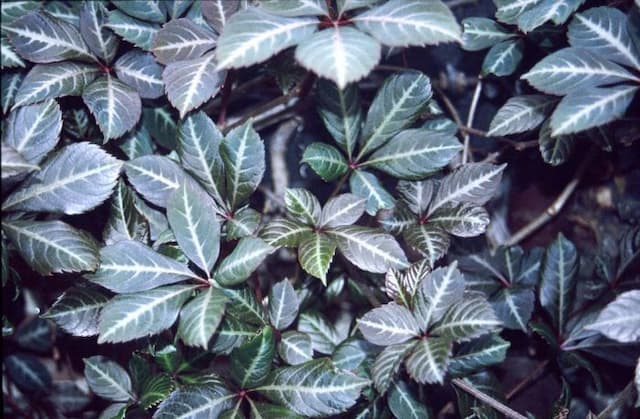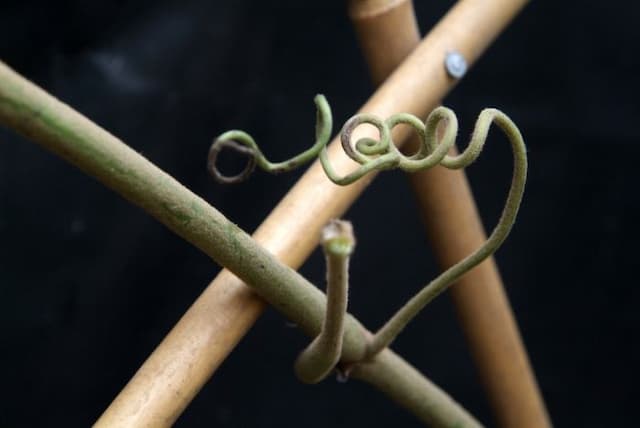Lakemont Seedless Grape Vitis vinifera 'Lakemont' (O/w/s)

ABOUT
The Vitis vinifera 'Lakemont', commonly known as the Lakemont grape or Lakemont seedless grape, is a variety of grapevine that produces attractive clusters of fruit. This particular variety is known for its seedless grapes which are typically small to medium in size and boast a fresh, light green to golden yellow hue when ripe. The skin of the fruit is thin and the flesh is firm yet juicy, offering a sweet and pleasant flavor. As a grapevine, Lakemont displays large, lobed, and toothed leaves with a distinctly veined pattern. The leaves are predominantly green, providing a lush backdrop for the hanging fruits. In the growing season, the Lakemont grapevine can produce an abundant crop of grapes, which hang in dense bunches that can be quite visually striking amidst the foliage. Overall, the appearance of the Lakemont grapevine reflects its use as both an edible crop and an ornamental plant, with the ripening grapes creating a picturesque look in any garden or vineyard.
About this plant
 Names
NamesFamily
Vitaceae
Synonyms
Lakemont Seedless Grape, European Grape, White Seedless Grape
Common names
Vitis vinifera 'Lakemont'.
 Toxicity
ToxicityTo humans
Grape is the most common name of Vitis vinifera 'Lakemont'. Grapes and their vines and leaves are generally safe for human consumption in typical dietary amounts. The fruit itself, when consumed as a food, doesn't pose a risk for the majority of people. However, for individuals with certain conditions, such as those with grape or wine allergies or rare metabolic syndromes like fructose malabsorption, grapes might cause adverse reactions.
To pets
Grape is the most common name of Vitis vinifera 'Lakemont'. For pets, especially dogs, grapes are toxic and can lead to acute kidney failure. Even small amounts of grapes or raisins can be poisonous to some dogs, though individual sensitivity varies. Symptoms of grape or raisin toxicity in pets may include vomiting, lethargy, diarrhea, reduced appetite, abdominal pain, decreased urination or anuria (complete cessation of urine), and acute renal (kidney) failure. If a pet ingests grapes, it is imperative to seek veterinary care immediately. The toxicity does not seem to extend to all animals, but it is particularly well-documented in dogs. Cats are also generally suspected to be susceptible, but there are fewer reports of toxicity in this species.
 Characteristics
CharacteristicsLife cycle
Perennials
Foliage type
Deciduous
Color of leaves
Green
Flower color
Greenish-yellow
Height
5-10 feet (1.5-3 meters)
Spread
10-15 feet (3-4.5 meters)
Plant type
Climber
Hardiness zones
7-11
Native area
Europe
Benefits
 General Benefits
General Benefits- Edible Fruit: Produces sweet, seedless grapes commonly used for fresh consumption and various culinary applications.
- Vineyard Diversification: Adds variety to vineyards with its unique seedless characteristic.
- Economic Value: Can contribute to the grape industry by offering a different grape option for markets and consumers.
- Landscape Aesthetics: Provides aesthetic value to gardens and landscapes with its attractive vine structure and foliage.
- Erosion Control: When planted on slopes, the plant's root system helps to stabilize soil and prevent erosion.
- Habitat Support: Offers habitat and food sources for various species of birds and other wildlife.
- Shade Provider: Can be used to create shaded areas in gardens or over arbors and pergolas.
- Pollination Support: Flowers attract and benefit pollinators like bees, which are essential for the ecosystem.
 Medical Properties
Medical Properties- Antioxidant: Grapes contain a variety of antioxidants like flavonoids and resveratrol, which may help reduce oxidative stress and can promote heart health.
- Anti-inflammatory: The compounds found in grapes have been shown to possess anti-inflammatory properties.
- Cardioprotective: Resveratrol in grapes is believed to benefit heart health by improving blood vessel function and lowering blood pressure.
- Anti-carcinogenic: Some studies suggest that grape compounds may have anti-cancer effects, although more research is needed.
- Neuroprotective: Resveratrol may also have a role in protecting nerve cells from damage and could play a part in preventing neurodegenerative diseases.
- Glycemic control: Grapes might help in managing blood sugar levels, potentially benefiting people with diabetes.
 Air-purifying Qualities
Air-purifying QualitiesThis plant is not specifically known for air purifying qualities.
 Other Uses
Other Uses- Vitis vinifera 'Lakemont', commonly known as seedless grape, can be used for natural dyeing purposes, where the skins of the grapes provide shades of purple and blue on fabrics.
- The vine canes of seedless grapes can be dried and woven into baskets, wreaths, and other decorative items due to their pliability and strength when soaked.
- The leaves of seedless grape can be used in culinary arts, especially in Mediterranean cuisine, where they are often stuffed with rice, meat, or grains to make dishes like dolmas.
- Grape seeds, a byproduct of juicing, can be pressed to extract grape seed oil which is used in gourmet cooking and as a salad dressing base.
- Seedless grape vines can be trained over arbors or pergolas to create natural green shading areas in gardens and patios.
- The tartaric acid extracted from seedless grape vines can be used in the manufacturing of natural baking powder and as an acidulant in various food products.
- The pressed skin and pulp left after juicing grapes, known as pomace, can be composted and used as a nutrient-rich soil amendment in gardens.
- Pomace from seedless grape can also serve as livestock feed, particularly for ruminants, due to its nutrient content and fiber.
- Extracts from seedless grape leaves and vines can be used as a natural preservative and stabilizer in the food industry.
- Seedless grape canopies can serve as microhabitat for beneficial insects and birds, promoting biodiversity within the ecosystem.
Interesting Facts
 Feng Shui
Feng ShuiThe grapevine is not used in Feng Shui practice.
 Zodiac Sign Compitability
Zodiac Sign CompitabilityThe grapevine is not used in astrology practice.
 Plant Symbolism
Plant Symbolism- Fertility - Vitis vinifera, commonly known as the grapevine, is traditionally associated with fertility, due to its abundant fruit production.
- Prosperity - Grapes have often been seen as a symbol of prosperity, as vineyards can be a source of wealth and success.
- Vitality - The grapevine's ability to grow vigorously and produce fruit is symbolic of vitality and robust health.
- Pleasure - With grapes being a key ingredient in making wine, they are commonly associated with pleasure, celebration, and enjoyment.
- Transformation - As grapes transform into wine through the process of fermentation, they also symbolize change and transformation.
- Abundance - The grape cluster itself is a symbol of abundance, representing plentifulness and generosity.
 Water
WaterWhen watering a Lakemont seedless grapevine, it's important to keep the soil moist without overwatering to prevent root rot. During the growing season, water deeply once a week with approximately 1 to 1.5 gallons of water per vine, depending on weather conditions. If the weather is particularly hot or dry, you may need to water twice a week. The goal is to mimic a good rain shower, allowing the water to penetrate deeply into the root zone. During the dormant season, reduce watering frequency as the vine requires much less moisture.
 Light
LightLakemont seedless grapevines flourish best in full sunlight, receiving at least 6 to 8 hours of direct sun daily. Place the grapevine in a location where it can receive unfiltered sunlight for the majority of the day to ensure optimal fruit development and vine health. Avoid shaded areas as inadequate sunlight can lead to poor fruiting and increase susceptibility to pests and diseases.
 Temperature
TemperatureFor Lakemont seedless grapevines to thrive, they prefer temperate climates with temperatures ranging between 50°F and 85°F. They can tolerate a minimum temperature of around 20°F, but temperatures below this can damage the vine or reduce the next season's yield. To ensure optimal growth and fruit production, maintain an environment within the vine's preferred temperature range.
 Pruning
PruningPruning Lakemont seedless grapevines is essential to manage vine structure, improve air circulation, and ensure optimal fruit production. Prune annually in late winter to early spring before new growth starts. Remove dead or diseased wood and thin out crowded areas to maintain an open canopy. The best time for pruning is when the vine is dormant to minimize the risk of disease entry and sap bleeding.
 Cleaning
CleaningAs needed
 Soil
SoilThe best soil mix for Lakemont Seedless Grape is well-drained loam or sandy loam, enriched with organic compost. Soil pH should be slightly acidic to neutral, ranging from 5.5 to 7.0 for optimal growth.
 Repotting
RepottingLakemont Seedless Grape vines grown in containers should be repotted every 2-3 years or when they become root-bound to ensure continued healthy growth.
 Humidity & Misting
Humidity & MistingLakemont Seedless Grape prefers a moderate level of humidity but is typically adaptable to the ambient outdoor humidity levels where it is grown.
 Suitable locations
Suitable locationsIndoor
Allow full sun, use large pot, provide support, and keep soil well-drained.
Outdoor
Full sun, well-drained soil, space rows 8-10 feet apart.
Hardiness zone
7-10 USDA.
 Life cycle
Life cycleThe life of Vitis vinifera 'Lakemont', commonly known as the Lakemont Seedless Grape, begins with seed germination, although, as a cultivated variety, it is most often propagated through cuttings or grafting. After planting, the young grape vine enters a stage of vegetative growth, where it develops a robust root system and vine structure with leaves. As the plant matures, typically within 2-3 years, it will undergo an annual cycle that starts with bud break in the spring, followed by flowering and subsequent pollination. After pollination, the flowers develop into clusters of green grapes which then enter a ripening stage, usually in late summer or early fall, where they gain their sweetness and flavor as well as the characteristic golden color of the 'Lakemont' variety. Upon reaching full maturity, the grapes are harvested, and the vine begins to prepare for dormancy by shedding its leaves and storing energy in its roots for the next growing season. During dormancy in winter, the plant undergoes pruning to sustain health and productivity before the cycle recommences with the next spring's bud break.
 Propogation
PropogationPropogation time
Spring-Early Summer
The Vitis vinifera 'Lakemont', commonly known as the Lakemont Seedless Grape, is typically propagated through hardwood cuttings. This method is most popular due to its simplicity and effectiveness. Hardwood cuttings are taken during the dormant season, usually from mid-winter to early spring, ensuring that they have mature, woody stems. Cuttings should be approximately 12 to 18 inches long with 4 to 6 buds, and the bottom cut should be made just below a bud. After the cutting is prepared, it is planted in well-drained soil with two-thirds of its length buried, leaving a few buds exposed above the soil line. The cutting then needs to be kept moist until it establishes a root system and begins to grow, marking successful propagation.









